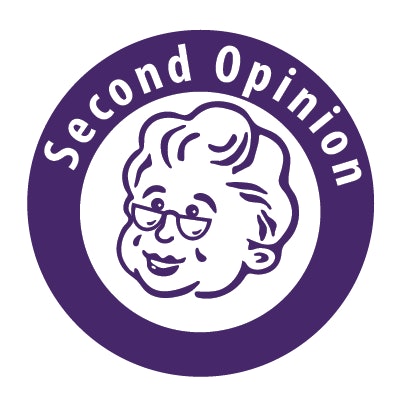
On March 9, AuntMinnie.com reported that the U.S. Preventive Services Task Force (USPSTF) had "doubled down" on its recommendation for shared decision-making in CT lung cancer screening, prompting the question among critics of exactly how useful shared decision-making is for this particular use.
To address the question, it is necessary to review the history of shared decision-making and decision aids for lung cancer screening. As I have earlier reported on AuntMinnie.com,1 the idea of shared decision-making originated with Dr. Peter Bach, who had served as senior advisor to the director of the U.S. Centers for Medicare and Medicaid Services (CMS).
 Dr. Fred Grannis Jr.
Dr. Fred Grannis Jr.In 2014, Bach testified before a Medicare Evidence Development and Coverage Advisory Committee (MEDCAC)/CMS committee and recommended that CT screening should not be covered by CMS. He went on to advise that if CMS did implement CT screening, shared decision-making must be incorporated.
CMS later ignored Bach's advice not to cover CT screening, but it did implement shared decision-making with mandatory consideration of a dozen specific components, covered in one or more "decision aids."
This recommendation was highly unusual. No other form of cancer screening carries a requirement for shared decision-making and decision aids. What evidence supported this recommendation?
Although Bach has claimed to hew to a standard of "evidentiary orthodoxy," the first reference retrieved in a PubMed search for "shared decision-making AND lung cancer screening" is from June 2014, after his MEDCAC testimony.2 This suggests that his initial recommendation for shared decision-making was made in a data vacuum. Given that modern healthcare policy should be based on a standard of high or, at minimum, moderately strong evidence, his recommendation and the subsequent CMS decision appear questionable.
That was seven years ago. What more recent evidence do we have on shared decision-making efficacy and value in CT lung cancer screening? Fukunaga et al published a systematic review of the literature on this subject in 2020.3 They screened 2,400 records and included 15 pertinent studies, including one randomized trial, and concluded that "Most studies were of fair quality." Hardly a ringing endorsement.
A team led by Dr. Richard Hoffman of the University of Iowa Carver College of Medicine in Iowa City -- and quoted in an article on the topic posted March 9 on AuntMinnie.com -- appeared to concur, acknowledging that "exactly how to offer this kind of interaction to patients is unclear."
To sum up, there is no more than fair evidence for a possible minor benefit of shared decision-making.
Is it harmful?
But is there evidence of harm? Although the National Lung Screening Trial (NLST) demonstrated a substantial mortality reduction with CT screening in 2011, uptake of CT lung screening remains very low -- 2% to 7%.4,5 Is it possible that mandated shared decision-making is contributing to low uptake, leading directly to a tragic failure to prevent lung cancer suffering and death?
There is evidence that understanding of the intricacies of CT screening among primary care practitioners (PCPs) is poor6 and although there have been some efforts to correct this deficiency with educational interventions, there is little proof that these suffice.7 Shared decision-making also places time and other constraints on the allocation of resources by already stressed PCPs.
Yet these problems pale in significance when compared with the problem of inaccurate information in current decision aids. It is axiomatic that patients will make bad decisions when provided with the wrong information. This is, in fact, the core rationale behind the use of decision aids for shared decision-making. Where did the inaccurate information come from?
The transcript of Bach's testimony at the April 30, 2014, MEDCAC meeting contains the following statement:8
"Decision tools are in development, and this is my fancy slide showing that in fact, every guideline recommends shared decision-making. I'm very proud of that. (Laughter.)"
This statement was disingenuous. In fact, Bach had already, in 2012, published an article intended to serve as a decision aid in shared decision-making for lung cancer screening.9 This publication contains inaccurate text and stick-figure graphics that have been copied into a large majority of the decision-aid pamphlets and websites used in shared decision-making over the past few years, including a pamphlet from the American Thoracic Society.10
The assertions in these decision aids are not off by a little; the misinformation is gratuitous. They inform screen-eligible patients that their risk of lung cancer is 2.1%, but a current NLST publication shows that lung cancer risk is more than three times higher, at 6.7%.11
Because NLST only provided three CT scans over two years, this figure is also falsely low. A high-risk cohort in the International Early Lung Cancer Action Program (I-ELCAP) study at the University of Toronto showed a 20.8% incidence of lung cancer on longer follow-up.12
In a media interview, Bach went a step further to assert falsely that "4 out of 5 of the lung cancers in laymen's terms snuck through and were incurable despite routine screening."13 In fact, routine screening had ceased before diagnosis in a high percentage of these unfortunates.
Long-term survival after screen detection in NLST was 62%,14 and a 2021 NLST publication shows that patients diagnosed by screening in stage 1 experience 10-year actuarial survival of 80%.15 A number of recent European randomized controlled trials show substantially better mortality reduction than NLST. 16,17
The stick-figure diagrams also inform patients of a high risk of false positives and of invasive procedures and complications resulting from these. In media comment, Bach has magnified this misinformation: "This is the clinical problem: 19 CTs of 20 have a false positive," he said. "One has lung cancer -- everyone else is potentially harmed."
Multiple screening studies that incorporate a diagnostic algorithm (NLST did not) -- for example, the Dutch-Belgian Randomized Lung Cancer Screening (NELSON) trial -- show substantially lower false-positive rates.18
CMS persists in mandating that shared decision-making must also inform patients of a substantial risk of overdiagnosed lung cancers, which will never cause symptoms or kill. One estimate from National Cancer Institute (NCI) authors suggested that more than 80% of screen-detected cancers might be overdiagnosed.19 A recent update of NLST based on longer follow-up shows that the excess of lung cancer in the CT arm is actually only 1%.20,21
Is shared decision-making a "Trojan horse" intended to dissuade primary care providers and at-risk patients from participation in CT screening programs? I believe this is a working hypothesis that must be carefully considered.
In the March 9 AuntMinnie.com article, Hoffman was quoted as saying that the "purpose of the shared decision-making visit is not to influence overall screening rates, but to ensure that the values and preferences of an informed patient are part of the screening decision."
I disagree. The purpose of informed consent in medicine is to provide the patient with the best available evidence on the efficacy and safety of treatments that may prevent death and disability. Shared decision-making in lung cancer screening does not currently meet this standard. It has minimal demonstrable benefit and may be causing substantially more harm than benefit.
Accordingly, it is my considered opinion that Medicare should withdraw its mandate for shared decision-making -- now. If CMS is unwilling to do so, as an absolute minimum, it must immediately ensure that decision aids utilized in shared decision-making contain timely and accurate information. The author has recently participated in a group effort to do this. This article contains accurate information that should replace misinformation in current decision aids.22
References
- Grannis FW Jr. CT lung screening meeting: A travesty of public health policy. AuntMinnie.com website. https://www.auntminnie.com/index.aspx?sec=ser&sub=def&pag=dis&ItemID=107339. Published May 8, 2014.
- Richards TB, White MC, Caraballo RS. Lung cancer screening with low-dose computed tomography for primary care providers. Prim Care. 2014;41(2):307-330.
- Fukunaga MI, Halligan K, Kodela J, et al. Tools to promote shared decision-making in lung cancer screening using low-dose CT scanning: A systematic review. Chest. 2020;158:2646-2657.
- Jemal A, Fedewa SA. Lung cancer screening with low-dose computed tomography in the United States -- 2010 to 2015. JAMA Oncol. 2017;3:1278-1281.
- Li J, Chung S, Wei EK, Luft HS. New recommendation and coverage of low-dose computed tomography for lung cancer screening: uptake has increased but is still low. BMC Health Serv Res. 2018;18(1):525.
- Volk RJ, Foxhall LE. Readiness of primary care clinicians to implement lung cancer screening programs. Prev Med Rep. 2015;2:717-719.
- Ortmeyer K, Ma GX, Kaiser LR, Erkmen C. Effective educational approaches to training physicians about lung cancer screening. J Cancer Educ. 2020;10.1007/s13187-020-01784-4.
- MEDCAC Meeting 4/30/2014 - Lung cancer screening with low dose computed tomography. Centers for Medicare and Medicaid Services website. https://www.cms.gov/medicare-coverage-database/details/medcac-meeting-details.aspx?MEDCACId=68&NCAId=6&. Accessed March 8, 2021.
- Bach PB, Gould MK. When the average applies to no one: Personalized decision making about potential benefits of lung cancer screening. Ann Intern Med. 2012;157:571-573.
- American Thoracic Society decision aid for lung cancer screening with computerized tomography (CT). American Thoracic Society website. https://www.thoracic.org/patients/patient-resources/resources/decision-aid-lcs.pdf. Accessed March 16, 2021.
- National Lung Screening Trial Research Team. Lung cancer incidence and mortality with extended follow-up in the National Lung Screening Trial. J Thorac Oncol. 2019;14(10):1732-1742.
- Kavanagh J, Liu G, Menezes R, et al. Importance of long-term low-dose CT follow-up after negative findings at previous lung cancer screening. Radiology. 2018;289(1):218-224.
- Sox H, Bach P. Lung cancer screening guidelines updated. Cancer Network website. https://www.cancernetwork.com/view/lung-cancer-screening-guidelines-updated. Published May 24, 2012.
- Yip R, Henschke CI, Yankelevitz DF, et al. The impact of the regimen of screening on lung cancer cure: A comparison of I-ELCAP and NLST. Eur J Cancer Prev. 2015;24(3):201-208.
- Gierada DS, Pinsky PF. Survival following detection of stage I lung cancer by screening in the National Lung Screening Trial. Chest. 2021;159(2):862-869.
- De Koning HJ, Van der Aalst CM, De Jong PA, et al. Reduced lung-cancer mortality with volume CT screening in a randomized trial. N Engl J Med. 2020;382(6):503-513.
- Pastorino U, Silva M, Sestini S, et al. Prolonged lung cancer screening reduced 10-year mortality in the MILD trial: New confirmation of lung cancer screening efficacy. Ann Oncol. 2019;30(7):1162-1169.
- De Koning HJ, Van der Aalst CM, De Jong PA, et al. Reduced lung-cancer mortality with volume CT screening in a randomized trial. N Engl J Med. 2020;382(6):503-513.
- Welch H, Schwartz L, Woloshin S. Are increasing 5-year survival rates evidence of success against cancer? JAMA. 2000;283:1975-1978.
- National Lung Screening Trial Research Team. Lung cancer incidence and mortality with extended follow-up in the National Lung Screening Trial. J Thorac Oncol. 2019;14(10):1732-1742.
- Grannis FW Jr. Lung cancer incidence and mortality with extended follow-up during screening. J Thorac Oncology. 2019;14(10):1692-1694.
- Sands J, Tammemägi MC, Couraud S, et al. Lung screening benefits and challenges: A review of the data and outline for implementation. Thorac Oncol. 2021;16(1):37-53.
For more information on this topic, please visit the author's web page.
Dr. Frederic W. Grannis Jr. is an emeritus clinical professor of thoracic surgery at the City of Hope National Medical Center in Duarte, CA.
The comments and observations expressed here are those of the author and do not necessarily reflect the opinions of AuntMinnie.com.




















